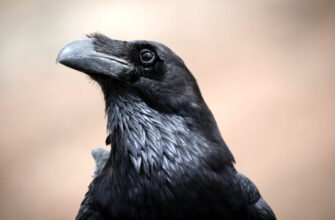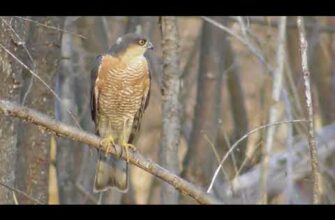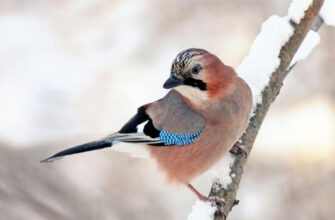Harzel grouse — motley, justifying its name, a bird from the genus of the same name, therefore the Latin binomial name is known as «Bonasa bonasia». Description and name given by Linnaeus in 1758. This is a typical inhabitant of the coniferous forests of Eurasia.
Origin of the species and description
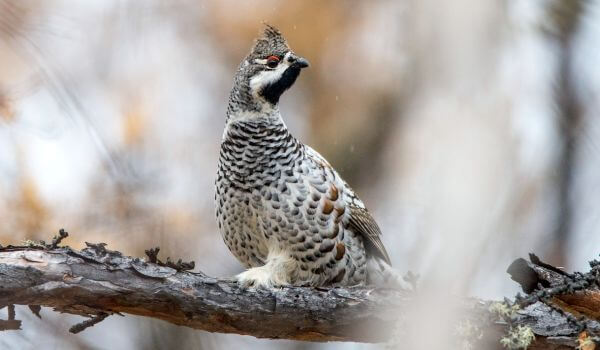
Photo: Hazel grouse
Birds belong to a large order of galliformes. The closest relatives are the pheasant family. These are the smallest grouse: their weight barely reaches 500 g. The genus of hazel grouse, in addition to the main one, includes ten more subspecies.
All of them are similar to each other, differ in habitats and slightly in appearance and size. These differences can only be determined by a specialist upon closer examination.
Video: Grouse
Although hazel grouse are very similar to their counterparts — black grouse, there is even evidence of a cross between this bird and other representatives of the subfamily, but genetic studies indicate isolation from the rest of the grouse. The first variational divergence occurred during the separation of collared hazel grouse. Then the nominate subspecies and Severtsov's hazel grouse appeared.
The bird can be found wherever spruce, pine or mixed forest grows throughout Eurasia, it is a typical inhabitant of the taiga. Birds spend most of their time on the ground, if something frightens them, they fly up to branches closer to the trunk, but do not move far. Grouse do not migrate, living settled in one place.
Interesting fact: Hazel grouse has always been a commercial object because of its delicious meat. It has a peculiar, slightly bitter, resinous aftertaste. Most often, during the winter hunting, various snares, loops are placed on him, and even caught with a net. When hunting with a dog, it drives a hazel grouse up a tree, making it possible to shoot game.
Appearance and features
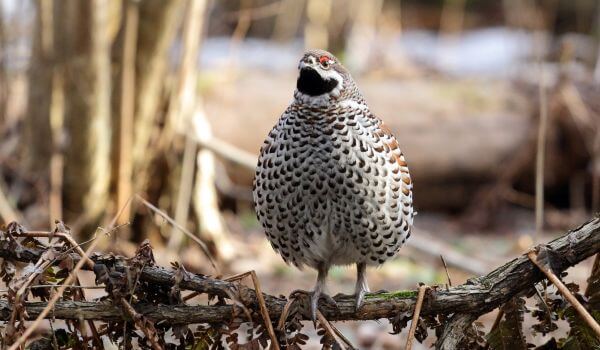
Photo: Hazel grouse bird
The bird has a peculiar appearance who once saw her, he is unlikely to confuse. She, with a small weight – about 500 grams, looks rather plump, while the head is rather small. This impression is enhanced by a small (10 mm) black beak with a slightly curved tip.
The bird is dressed in a rather colorful plumage. The variegation consists of white, gray, black and reddish spots that merge into stripes, semicircles, but from afar it looks like a uniformly grayish, slightly tinted red, gray legs. Coloring well masks the hazel grouse. The neck in males is black, and in females it is similar to the general color of the breast.
Around the black eyes there is a burgundy-red rim, which is brighter in males. For males, a crest on the head is characteristic, in females it is not so pronounced, and they are slightly smaller in size. By winter, the bird, acquiring a more magnificent outfit, becomes lighter, updated feathers have a wider light border. This helps the birds better camouflage among the snowy forest.
If you look at the footprints in the snow, you can see three fingers pointing forward and one back, that is, like a normal chicken, but much smaller. The average step of a bird is about 10 cm.
Where does the hazel grouse live?
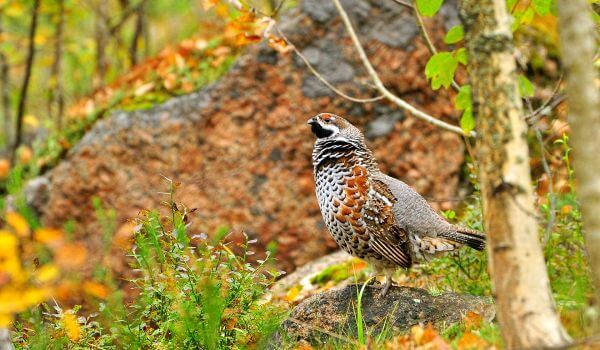
Photo: Hazel grouse in spring
Grouse live in mixed forests. In pine forests, they can only be found where there is dense undergrowth and fern, but they avoid high and dense grass covers. This cautious secretive bird can rarely be found on the edge of the forest or the edge, only in the most thicket. Rugged terrain, forest along the banks of streams, lowlands, spruce forests with the presence of deciduous trees: aspen, birch, alder — here hazel grouse feel comfortable with a fairly good food supply.
Previously, they were found in Central and Western Europe, but have disappeared from this region for more than a century. Now the species is distributed in Eastern Europe to the Far East. It is found in the north of the Japanese islands, although its numbers are declining there, in Korea. In the past, the hazel grouse was found in large numbers in the forest regions of China and Mongolia, but after the area occupied by forests decreased there, the bird's habitat narrowed significantly.
In the west of the European continent there are separate areas where you can meet a bird, for example, in France, Belgium. In the south, the distribution boundary runs along the Altai Mountains, in Mongolia along the Khangai Mountains and the spurs of Khentei, in China along the Greater Khingan, and then along the middle part of the Korean Peninsula. The range covers Russian Sakhalin and Japanese Hokkaido. In the southern regions, hazel grouse can be found in certain regions of the Caucasus, the Tien Shan, in the east – in Kamchatka.
What does a hazel grouse eat?
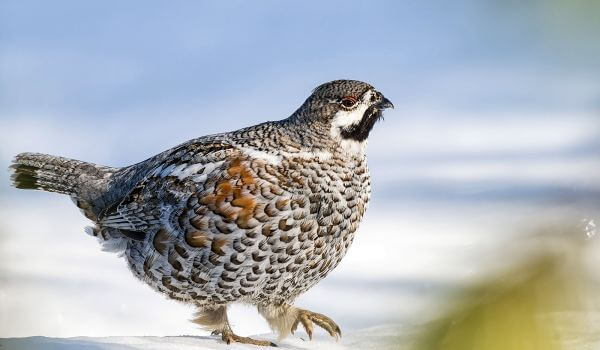
Photo: Hazel grouse in winter
The diet of hazel grouse includes both plant foods and insects. Chicks, at the initial stages of life, feed on insects, eggs (pupae) of ants, then gradually switch to plant foods.
Interesting fact: Only hazel grouses have a pronounced seasonal diet. Moreover, the sections of the bird's intestines that are responsible for the fermentation of coarse plant fibers. In the summer, when the main menu consists of young shoots, berries, insects, it simply does not work.
From the beginning of spring, as soon as insects appear, hazel grouses actively eat forest smelly bugs, beetles, ants, grasshoppers and their larvae, as well as slugs. From vegetable feed they prefer: seeds of various forest grasses, inflorescences and young shoots of bushes, catkins of birch and alder.
From berries:
- Rowan;
- Viburnum;
- Bird cherry;
- Rosehip;
- Hawthorn;
- Cowberry;
- Blueberries;
- Bone fruit;
- Wild currant;
- Strawberry and others
The main share of the diet can be modified, depending on the region of habitat. It can include from two and a half to six dozen names of plants. The harvest of pine nuts has a great influence on the nutrition of hazel grouse. His bird eats with great pleasure, fattening at the same time. In lean years, the livestock of this grouse representative decreases sharply. But the accumulation of fat can also occur due to spruce or pine seeds.
An interesting fact: Only those representatives of this genus that live in Siberia, with its harsh weather conditions and frosty winters, “grow fat”.
Birds spend a lot of time on the ground, it is there that they find food for themselves and only closer to autumn they spend more time on trees, looking for seeds.
An interesting fact: To digest food, hazel grouse, like ordinary chickens, it is important to swallow small pebbles, which “grind” rough stones in the goiter fibers. Even two-week-old chicks peck at small fractions of pebbles or grains of sand.
In autumn, birds choose gastroliths along the roadsides of forest roads or the banks of taiga streams, on mountain screes. Pebbles are especially important in winter, when the proportion of roughage increases dramatically. In winter, birds feed on the soft tips and buds of deciduous plants. This food is less caloric, and therefore the birds are forced to increase its volume by two to three times, compared with the summer period. By weight, the daily food intake can reach up to 50 g, and in summer it is no more than 15 g.
In winter, hazel grouse under the snow find cranberries or blueberries. In early spring, when cones open under the sun's rays, the seeds that spill out of them help emaciated birds to successfully complete the winter.
Peculiarities of character and lifestyle
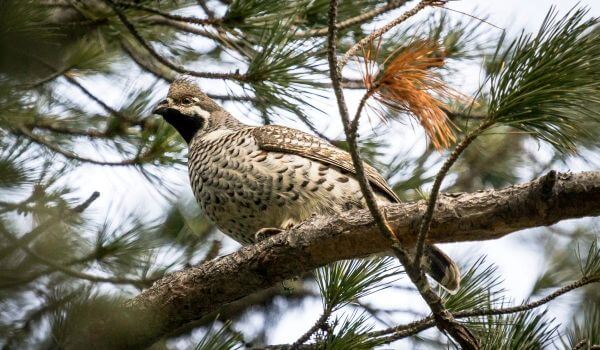
Photo: Animal hazel grouse
The hazel grouse does not often give a voice, but if it does, you can hear a piercing whistle, in At the beginning, two long sounds sound and then several more abrupt, fractional sounds.
An interesting feature of this bird in the winter lifestyle. Like black grouse, these small members of the family spend the night in the snow. This is not only a way to hide from predators and keep warm under a layer of snow, but also an opportunity to warm up the contents of the goiter. Since the buds and branches that the bird eats are in a frozen state, it takes a lot of energy to digest them so that they thaw. This is difficult to do in cold weather. So the birds hide under the snow if the air temperature drops below zero.
They dive into the thickness directly from the branches where they found their food. To do this, it is enough that the depth of the cover is at least 15 cm. If the snow is dense, then the hazel grouses break through the passage and the hole in which they hide. Having dived into the loose snow, the birds dig a passage, with their paws, and then shovel the snow with their wings, therefore, by the end of winter they have a slightly shabby appearance.
As they move under the snow, the hazel grouse makes holes, looking around. Such holes are located along the entire length of the stroke at a distance of about 20 cm. In the very frosts, birds in such shelters can spend most of the day, flying out only once or twice to feed. The bird covers the hole with snow, it does it with its head.
In such a snow lair, a constant temperature is maintained, at about minus five degrees. It does not fall below, and if it gets warmer, the bird makes an additional hole “for ventilation”. Therefore, inside the course and “laying down” the surface of the snow does not melt and is not covered with frost, and the bird's feather is not moistened.
As a rule, hazel grouses always hide under the snow in the same places. Predatory animals and hunters can easily detect such lairs by their characteristic droppings. In summer, hazel grouses keep their own territory, not letting strangers in, but in winter they often keep in small groups or in pairs. But even in this case, they place holes at some distance, up to about 6-7 meters.
Social structure and reproduction
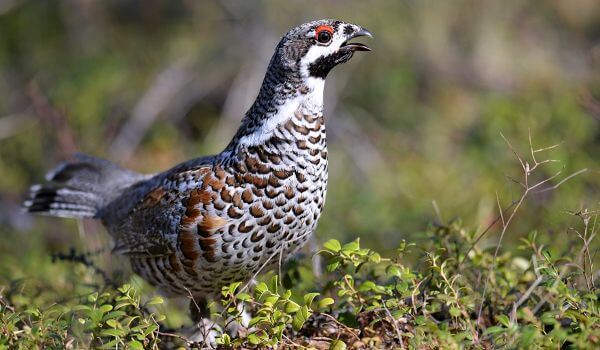
Photo: Fritillary bird
This bird is characterized by monogamy. The mating season begins in the spring – the end of March & # 8212; beginning of April, depending on weather conditions. In different regions, it can last until the twentieth of May (where it is warmer) and until June – early July – in more severe conditions.
Interesting fact: The readiness of males to mate is affected not only by climatic conditions, but also the length of daylight hours.
The mating season for hazel grouse, as members of the grouse family, is associated with mating, but they do not gather in several pieces on their lek, but look after their partner individually on their own plot. Each individual has its own territory, which it vigilantly guards and protects. When an enemy appears, a fight is inevitable. When lekking males are close to each other, they boldly cross the borders of a neighbor to engage in combat with another challenger.
During such collisions, males take on more aggressive postures:
- On the “beard”, the feathers stand on end;
- The neck and head are stretched forward;
- All the plumage fluffs;
- The tail becomes a vertical fan.
During the current, the male opens his wings, unfolds his tail, the whole becomes more fluffy, more voluminous, as if trying to look more impressive and attractive to the female, the crest raises vertically. At this time, he moves quickly across the ground, dragging his wings. Makes special whistling, inviting sounds. The female is nearby, responding with shorter whistling trills, and runs to the call.
Mating takes place immediately, then the couple stays nearby for some time. Then the whole process is repeated again. During the mating season, males lose a lot of weight, as they hardly eat, and females at this time gain weight heavily before laying eggs and incubating chicks.
The hazel grouse's nest, about 20 cm in diameter, is difficult to detect; it settles under a pile of deadwood, in a small hole. The bird covers it with dry grass, last year's foliage. In rare cases, birds use the abandoned nests of other birds.
At the end of spring, the female lays about 8 eggs with a diameter of about 30 mm, up to 40 mm long (the number can vary from three to fifteen). The shell has a yellowish-sandy color, often with brown speckles, the color of the eggs, in the process of incubation, fades. It is impossible to notice a hidden bird sitting on a nest, so it merges with the surrounding background.
Only the female is engaged in the process of incubation of eggs, it lasts about three weeks. The male is always nearby both during this period and at the time when the hen is with the chicks, but does not take part in raising and hatching.
Interesting fact: The male, in the event of the death of the female, can take care of the offspring.
Babies hatch at the end of May — early July, depending on the region. Chicks, like chicken chickens, appear immediately with fluff and, after they dry, begin to run, but they quite often hide under the wing of their mother to warm themselves. From the first days, under the supervision of their mother, they hunt small insects on the lawns in the morning and evening. The female replenishes their menu with ant eggs, bringing them to the surface. In the daytime, they are buried in bushes, deadwood, thick grass.
After the plumage appears, by the end of the first week they can fly up, and by the age of two weeks they fly into trees. At the age of ten, they weigh about 10 g, then they begin to quickly gain weight, and by two months they reach the size of adults, by this time acquiring plumage familiar to hazel grouse. At the end of August — in early September, the brood breaks up, and the matured chicks begin an independent life.
Natural enemies of hazel grouses
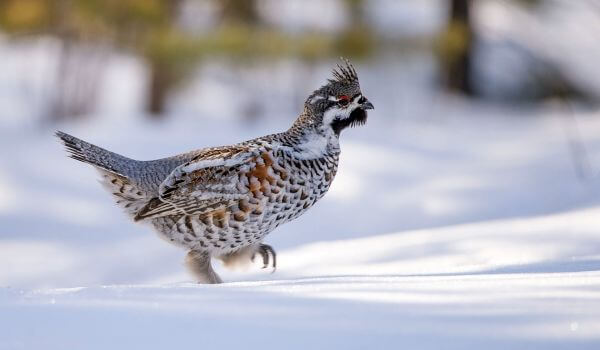
Photo: grouse
One of the main enemies of grouse during marten are present all year round, and in Siberia – representatives of this extensive family – sable. He prefers this bird to all others, even if given the choice.
Interesting fact: During the winter season, sable can eat more than two dozen grouse.
The fact that the bird is on the ground most of the time makes it accessible to various predators. Foxes, lynx, ferret, marten, weasel – all of them are not averse to eating a small representative of pheasants. Birds of prey also attack this bird: owls, hawks.
In winter, to escape the cold and hide from predators, hazel grouses burrow into the snow. Knowing this feature, hunters in such places place snares and even catch game with nets. But mustelids can also find hazel grouse under the cover of snow. Often the birds are saved by the fact that they break through rather long passages from one to four meters. Before they are overtaken by a predatory animal, they have time to take off from their snowy shelter.
Wild boar pigs can destroy bird nests by eating eggs, they greatly affect the bird population in the region.
An interesting fact: martens not only eat hazel grouse, but also make stocks from this bird.
Parasites can also be considered enemies of hazel grouse, there are about one and a half dozen different types of worms, from which birds suffer and die.
A person also affects the population. Grouse is one of the types of upland game, which for many centuries has been hunted in some areas and is still being hunted today. But even more harm is caused by the destruction of the ecological system – deforestation. In Siberia, there are annual extensive fires that destroy many hectares of forest, and in the place with it all life.
Population and species status
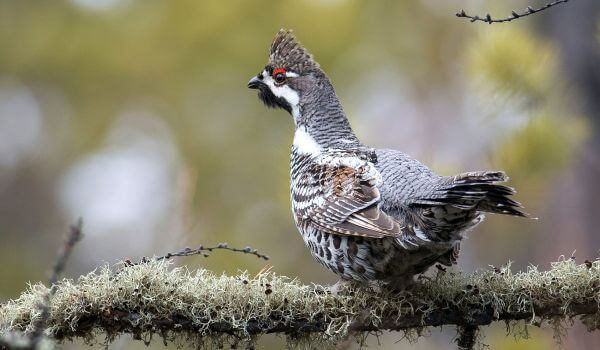
Photo: Hazel grouse
In connection with the destruction of forests, the population of hazel grouse, which used to be large, has noticeably decreased. In the middle of the last century, in the European part of Russia in the north, on an area of one hundred hectares, there were two to three and a half dozen birds. In central Russia, there were regions where up to a hundred individuals lived on the same territory.
The number of birds tends to decrease and rupture their habitats due to human impact on nature. But this species still inhabits most of the historical territory and is not on the verge of extinction.
In general, in Europe, the population reaches 1.5-2.9 million pairs of birds, which is approximately 30% of the total number . In total, in Eurasia, the estimated number of these birds is 9.9-19.9 million.
- 10-100 thousand pairs nest in China;
- In Korea, about 1 million pairs;
- In Japan, 100,000-1 million pairs.
The bulk of the population falls on Russia. Recently, due to the refusal to hunt on a large scale for the export of poultry, the population in the Russian Federation and in the countries of the post-Soviet space has somewhat stabilized.
In addition to the anthropogenic impact, cold winters with thaws can also affect population change. When the crust is formed, birds cannot burrow into the snow. Left for the night in the open air, the birds die from hypothermia. Often, hazel grouses are trapped in the ice while under the snow. Due to various reasons, only 30-50 percent of chicks survive to adulthood in hazel grouses, a quarter of them die in the first days.
The international status of this bird is assessed as being under the least threat.
Hunting this bird is prohibited in some European countries. In Germany, measures were taken to reintroduce hazel grouse. In Finland, constant monitoring is carried out to account for the population.
In order to increase the number of these birds, measures are needed to preserve intact large areas of forest and carry out afforestation work where they have been destroyed by fires or humans. Restoration of the habitat and links between individual population foci is of great importance. Protected areas help in maintaining a stable population. The hazel grouse is a very interesting and unusual bird, the population of which should not decline.

